9 HR Concepts and Terms You Should Know

Human Resource Management isn’t easy! In this article, we will discuss 9 common HR concepts and terms. We will start with some of the more basic ones before discussing the more expert level HR terms. These are the HR concepts every HR professional, whether starting or having decades of experience, should know.
What’s in:
- Engagement
- Job demands-resources model
- Strategic Human Resource Management
- HR analytics
- Employee turnover
- Applicant tracking system
- HR report
- Employee experience
- 360-degree survey
1. Engagement
Let’s start easy. The first term every HR generalist should know is engagement.
Engagement has been the holy grail of HR for a long time. Most of us are familiar with engagement. It is said to lead to higher productivity, lower absence, lower employee turnover, higher product quality, and fewer product defects.
Engagement is the polar opposite of burnout. While people who classify as being burned out have low energy, are emotionally detached from work and are cynic (Maslach, Schaufeli & Leiter, 2001), people who are engaged are high in energy, dedicated to their work, and often lose their sense of time when working.

The image above shows the differences between work and business outcomes of the top 25% in employee engagement versus the bottom 25%. It explains why HR has put so much attention on trying to measure and promote employee engagement.
2. Job demands-resources model
The second HR concept, or HR term, is the job demands-resources (JD-R) model. The JD-R model is an occupational stress model.
The model proposes that every occupation has its own specific risk factors associated with job stress. These factors can be classified into two general categories. These are job demands and job resources.

The model shows that job demands lead to strain (and eventually burnout), while job resources lead to motivation (and eventually engagement). Job demands are driven by the mental, emotional and physical demands of the job, which are mainly influenced by work overload and time pressure.
On the other hand, Job resources lead to motivation. Examples of job resources are autonomy, salary, esteem, security, and career opportunities.
The JD-R model proposes that job resources form a buffer for job demands. This means that if demands are high, job resources should also be high in order to provide a buffer. If this is not the case, there is a risk of strain and (in the long term) burnout.
From an organizational perspective, high motivation and low strain, lead to better organizational outcomes. These are the outcomes we saw earlier: high productivity, higher customer satisfaction, and higher profitability.
All in all, the JD-R model provides a comprehensive framework to manage stress and engagement at work and to drive positive business outcomes.
For more information about these and other common HR models, check the link for a full article!
3. Strategic Human Resource Management
We already wrote an extensive article about human resource strategy and Strategic Human Resource Management. The latter is an important HR term.
Strategic Human Resource Management was popularized in the early 2000s by Dave Ulrich and contemporaries. In a 1998 article, Dave Ulrich stated: “HR should not be defined by what it does but by what it delivers – results that enrich the organization’s value to customers, investors, and employees”.
In the following years, HR professionals responded to this challenge and HR became more strategic. This is also when the HR Business Partner role emerged: an HR advisor who not only contributed operationally but also on a tactical and strategic level: Strategic HRM was born.
The goal of Strategic HRM is for HR to align its activities with the objectives or the organization. When this is done right, HR will help the organization reach its goals. The promise of Ulrich – and strategic HRM for that matter – is that when done right, HR will convert from a fee-burner to a fee-earner, giving it the seat at the (board) table it has desired for so long.
4. HR analytics
The next term covers this process of aligning HR activities with the strategic objectives of the organization. It’s all good and well to think we train our people much more than we did last year – but does this actually contribute to the company strategy?
This is where HR analytics comes in. HR analytics, also called people analytics, is a data-driven approach to managing people at work (Gal, Jensen & Stein, 2017). HR analytics helps to quantify if and how HR processes contribute to organizational objectives.
This data-driven approach to managing people has proven to be very successful. Using turnover analytics, companies like Credit Suisse were able to save between $70 – $100 million annually by reducing their internal turnover, according to the Wall Street Journal.
Other examples include Best Buy, a large electronics chain. They were able to relate engagement to store revenue, finding that a 0,1 percentage point increase in engagement resulted in a $100,000 increase in store revenue, according to Harvard Business Review.
HR analytics is evolving strategic HRM into something that can be quantified.
5. Employee turnover
Employee turnover is the next HR term. It might sound simple – but it is much more complicated in reality. When it comes to turnover, there are a number of challenges.
First of all, turnover isn’t necessarily good or bad. There are two kinds of turnover: regretted and unregretted loss. Regretted, or undesired turnover happens when high performers leave. Unregretted loss, or wanted turnover, happens when bad performers leave.
Some regretted turnover is inevitable. However, high levels of regretted loss can be disastrous for an organization. One of the key responsibilities of HR should be to manage and retain high potentials and key talent.
Another challenge is the calculation of turnover. This may sound easy – but it is much harder in reality. We have a full guide on how to calculate employee turnover rates, including the formulas. This is highly relevant when you’re doing HR analytics or reporting – but less so if you’re an HR generalist.
6. Applicant tracking system
Another key HR concept is the applicant tracking system or ATS. An applicant tracking system is a Human Resource Information System (HRIS) aimed at handling recruitment and hiring needs.
An ATS is a customer relationship management (CRM) system for recruitment. Whenever a candidate applies to a company, their profile will be stored in the ATS. The ATS can be used to search for profiles (via connections with job en resume boards like LinkedIn, Monster, and so on), send vacancies to job boards, match candidates to job, and invite them for interviews.
7. HR report
The HR report is next on the list. These days, all HRISs have the functionality to create reports. These are, in a way, a print out of the data in the system.
Besides the HR report, there is the HR dashboard. The HR dashboard is an interactive report. It usually provides the functionality to ‘slice and dice’ data, meaning that you can inspect specific departments, teams, locations, or function groups.
The HR report and dashboard enable you to get insights into your data and work in a more data-driven way. High-quality HR reporting enables you to ‘slice and dice’ data from different systems. For example, to know what percentage of turnover is regretted, you need data from your basic HRIS and you need data from your performance management system. By combining these data sources, you can determine if a loss is regretted or not.
8. Employee experience
One of the HR terms that’s coined more and more often is employee experience. Employee experience is the way employees feel about what they encounter and observe over the course of their employee journey at an organization.
Employee experience offers a somewhat new perspective to doing HR. Where employee engagement is seen as an employee outcome, employee experience is the way HRM is perceived. It is thus seen as a driver of employee and organizational outcomes.

Because employee experience is such a novel topic, it hasn’t really caught on in literature (yet). Further studies will have to show if the business outcomes associated with employee experience are similar to those in employee engagement.
9. 360-degree survey
The 360-degree survey is another well-known HR concept. 360 surveys are a method to collect feedback from multiple perspectives. It usually involves one’s manager, colleagues, subordinates, and customers, providing a full picture of one’s behavior.
360-degree surveys are mostly used for managerial performance feedback. The instrument is popular – but not always successful. In fact, literature shows that such an assessment is successful in only one-third of cases. In another one-third of cases, the survey does not provide benefit, and in the remaining one-third of cases, it even leads to worse performance (Kluger & DeNisi, 1996)!
This shows that the conditions in which a 360-degree feedback instrument will be successful, are unique. For a full description of best practices, and tips on how to make the 360 survey more effective, check our full guide on 360-degree feedback.
Wrapping up
That’s it for the 9 HR concepts and terms you should know when you work in HR. Did you know all of them? I tried to take a few deep dives into some of them and give you a bit of a ‘behind the scenes’ that explains some of the elements of the HR professional’s job. As always, suggestions, feedback, and comments are more than welcome.
Weekly update
Stay up-to-date with the latest news, trends, and resources in HR
Learn more
Related articles
Are you ready for the future of HR?
Learn modern and relevant HR skills, online











